NVIDIA's GeForce GTX 465: Cheaper Isn’t Always Better
by Ryan Smith on May 31, 2010 3:26 AM ESTPower, Temperature, & Noise
In our GTX 480 review, we identified both the GTX 480 and GTX 470 as being abnormally hot & loud. Perhaps with the reduction in functional units and a lower memory clock speed NVIDIA will be able to bring this in to check? Let’s find out.
Or not.
Let’s first start with core voltage. For the GTX 400 series NVIDIA does not use a single voltage for each card, instead they assign voltage on a per-chip basis. So while there are trends we can look at, there is no absolute single voltage as we’ve seen on past cards. The following is the load voltage on each of our sample cards.
| GeForce GTX 400 Series Load Voltage | |||
| GTX 480 | GTX 470 | GTX 465 | |
| Load Voltage |
0.959v
|
0.962v | 1.025v |
In terms of core voltage the GTX 465 ends up being a notable outlier. Our GTX 480 and 470 samples have a load core voltage of 0.959v and 0.962v respectively according to GPU-Z, while our GTX 465 from Zotec is a good 0.04v higher at 1.025v. This is only a 4% increase in core voltage overall, but as GF100 has an idle voltage of .875v, this means it takes a 50% greater voltage increase over idle to bring our GTX 465 to load compared to our GTX 470.
NVIDIA is dealing with some very tight thermal and power requirements on the GTX 480 and 470 – getting a 3 billion transistor chip to not run amok drawing power is hard work. From this we can infer that NVIDIA is not only holding back chips with damaged functional units, but also chips that run but just take too much voltage (and ultimately power) to do so. With fewer functional units, the GTX 465 has a greater tolerance for high-voltage chips and it looks like this is where NVIDIA is sending some of them as a result. This is why there’s only a 15W TDP difference between the two cards: NVIDIA “spent” their savings getting lesser GF100 GPUs in to products. So going by voltage alone, it’s clear that we’re not going to see the GTX 465 receive a huge benefit in terms of power, temperature, & noise.
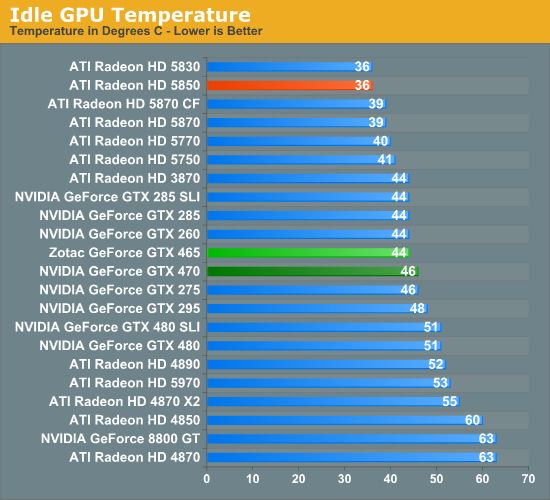
Moving on to our charts, we’ll start with idle temperatures. Even with the same idle voltage and same cooler as the GTX 470, the GTX 465 delivers a slight surprise: it ends up idling at 2C under the GTX 470. This puts it squarely in the same territory as the GTX 200 series.
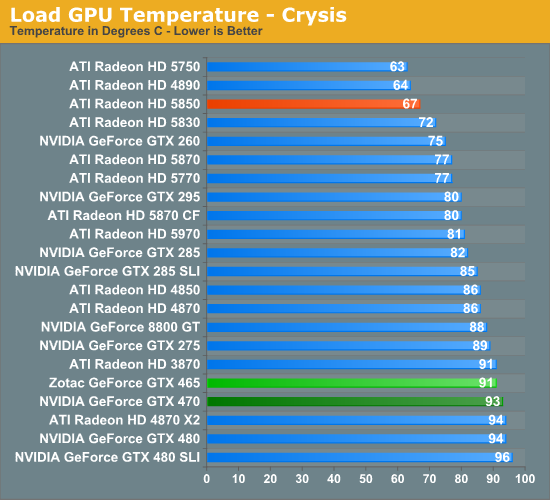
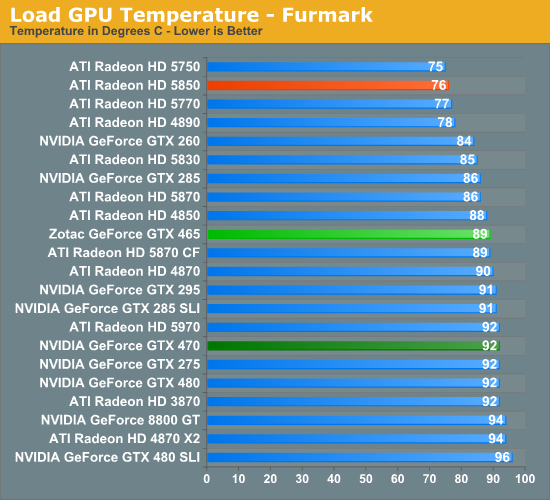
Moving on to load temperatures, we can begin to see the price of using a GPU with a higher core voltage. Under Crysis that 2C advantage over the GTX 470 holds, with temperatures peaking at just 91C. This still makes it the 3rd hottest single-GPU card we have tested, tieing with the Radeon HD 3870 and coming in 24C hotter than the 5850, a card it underperforms in this game.
FurMark has a similar showing, with the GTX 465 coming in 3C cooler than the GTX 470. Overall things are better for the GTX 465 here though, as it’s better than roughly half of our cards here, placing amongst the Radeon HD 4890, 4850, and only a hair above the 5870 and GTX 285. Even the gap between the GTX 465 and 5850 drops quite a bit, with only 13C separating the two.

Next we have idle power consumption, measuring the total power consumption of our GPU testbench. While NVIDIA didn’t give the GTX 465 an official idle power draw, we’re measuring it at 1W less than the GTX 470. The GTX 470 was rated for 33W, so it’s safe to say the GTX 465 is close to that. It’s quite likely that the difference comes down to the savings from running 2 fewer GDDR5 RAM chips.
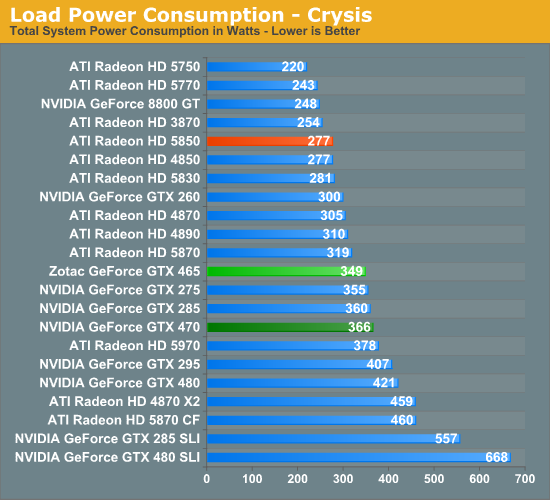
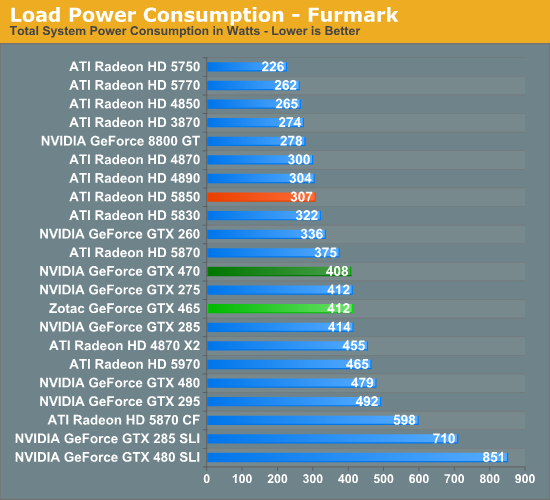
As for load power draw, having seen our temperature results the actual power figures should not be a surprise. Under Crysis the GTX 465 has more in common with the GTX 470 than the power-saving Radeon HD 5000 series, drawing 17W less than the GTX 470 and 72W more than the 5850. Based on our voltage numbers from earlier and this data, it’s clear that NVIDIA had to give up a lot of power savings to make this specific GPU operate.
Meanwhile under FurMark we see those savings evaporate in to nothingness. Here the GTX 465 actually surpasses the GTX 470 by 4W, coming in at 412W versus 408W. At this point it’s drawing as much power as a GTX 275/285, and 105W more than the Radeon 5850. We did not expect the GTX 465 to end up drawing more power than the GTX 470 here, as the 2 fewer RAM chips should have offset the difference. Looking at just the GPU, there’s a good chance the GPU in our GTX 465 card is drawing more power than the GTX 470 under most situations.
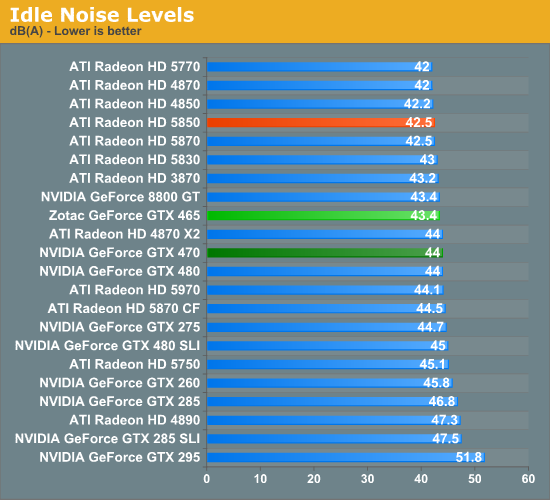
Last but not least we have our noise testing. As the GTX 465 uses the same cooler as the GTX 470, the results should be very close and our idle noise measurements deliver on that. Our GTX 465 idles at 43.4db(A), effectively tied with the GTX 470 and only marginally different than most of the rest of our cards.
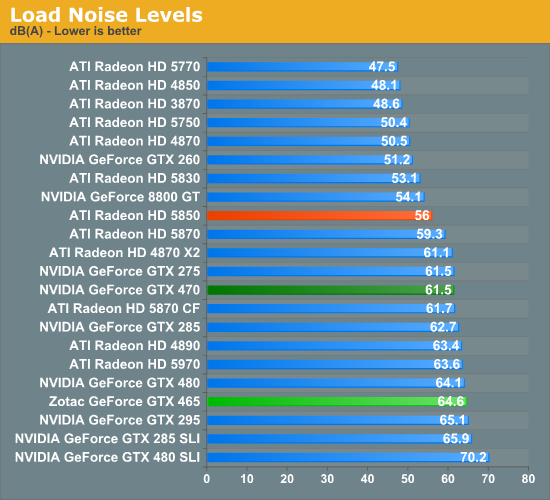
When we first did our load noise testing on our GTX 465, we thought something was wrong. It sounded louder than the GTX 480 or GTX 470, and when we put a sound meter to it the results reflected that. But after triple-checking our results there’s nothing wrong with our data – the GTX 465 really is louder than the GTX 470 and the GTX 480. As fan speeds are tied to the GPU temperature we’re looking at the culprit being the fan profile used for the GTX 465, as the hardware is identical to the GTX 470. It looks like NVIDIA tweaked the GTX 465 to be a bit more aggressive than the GTX 470, which in turn makes this the likely reason why we’ve measured the GTX 465 as being cooler than the GTX 470 in spite of their similar power draw.
Our best guess here is that with the GTX 465’s higher operating voltage, NVIDIA wanted a slightly lower operating temperature to compensate. As with any other case where we’ve only measured a single card there’s the possibility of a great deal of variation, but what we’ve seen makes sense. Across the entire spectrum of GTX 465 and GTX 470 cards it’s reasonable to assume this data is correct and that the GTX 465 is on average a couple of db(A) louder than the GTX 470.
It goes without saying that this isn’t a reasonable amount of noise for the performance the card delivers. The Radeon HD 5870 is 5dB(A) quieter, and the 5850 extends than to 8dB(A) quieter. At these noise levels 8dB(A) is a very noticeable difference.










71 Comments
View All Comments
BoFox - Tuesday, June 1, 2010 - link
Catalyst 10.4 refuses to work with 5830 cards. I'm not sure about 10.5's.. gotta check out the forums."""We've often thought that GPU performance in 3DMark's color fill rate test seems to be limited primarily by memory bandwidth. Notice how much faster the Radeon HD 4870 is than the Radeon HD 5770, for instance. The 5770 has a slightly higher theoretical peak fill rate, but the 4870 has nearly twice the memory bandwidth and proves markedly faster in this directed test.
The 5830, however, breaks that trend by delivering much a lower measured fill rate than the 5850, though their memory bandwidth on paper is identical. Heck, the 4870 outscores the 5830, too, even though it has slightly less theoretical peak fill rate and memory bandwidth. Something about the way AMD pruned back the Cypress GPU's render back-ends produces unexpectedly poor results in this test."""
http://techreport.com/articles.x/18521/5
Also, here's an excellent article with much more in-depth analysis on the issue: http://www.behardware.com...eview-radeon-hd-5830.h...
It's a very good read. The R800 architecture appears to have the ROP's linked to the memory controller (bus) in that cutting the ROP's in half really does affect the usage of the available bandwidth.
Simply put, the 5830 is even more of a castrated child of RV870 than the 465 is a castrated child of GF100.
Slayeristight - Wednesday, June 2, 2010 - link
But that does not explain why the 5830 performs better on its original review vs this new review. On the HAWX tests show 50%+ slower speeds! I would have thought someone would have seen this problem before the review was posted.Ryan Smith - Wednesday, June 2, 2010 - link
I'll rerun the 5830 later today. There's a pretty good chance I just wrote down the wrong numbers when compiling all of this date for the GTX 480 review, but ultimately you're right: there's something wrong with our HAWX data.Arbie - Wednesday, June 2, 2010 - link
It isn't just the cost of the wattage to run the card. That doesn't add much when you consider what a small percentage of the time the thing is loaded. The dominant factor, in most moderate or hot climates, is the cost of air conditioning to keep the computer room comfortable. With central A/C, to cool off a single hot room you have to refrigerate the rest of the house. That is not only very expensive but also inconvenient and uncomfortable.==> After the inefficiencies of your PSU and A/C are taken onto account, each watt of idle power probably translates into 3-4 watts you have to pay for. That's just a guess, but it is clearly pointless to argue about small differences in GPU dissipation without considering these multipliers. That's where the hurt is. And that's one of the *many* reasons to favor ATI now.
Technically, the Nvidia Fermi line is junk, and nobody who doesn't need the few special features of the architecture should be conned into buying one. That means most gamers. Thanks for a good article that doesn't pull any punches on this, and in fact exposes the over-volting Nvidia is resorting to in order to move their leaky culls. The GTX 265 is clearly the worst of Fermi yet.
I apologize if this double posts but it seems to have been lost the first time.
Arbie - Wednesday, June 2, 2010 - link
Typo: I meant "GTX 465" at the end, not 265.
Golgatha - Thursday, June 3, 2010 - link
This is a high end card review. I would personally like to see the 5770 and 5750 results omitted and replaced with 465/470 SLI and 5850 Crossfire results so we can make an intelligent buying decision based on an apples to apples comparison with currently shipping drivers.fingerbob69 - Tuesday, June 8, 2010 - link
see for yourself how a 5830 is rather lackluster even compared to the 4890 (which is already slower than GTX 275 and 465 in overall DX9/10 games).I'm sorry but that statement re275 v 4890 simply isn't true! If you examine the graphs for CrysisW. (in a "if it can render Crysis all other ingame rendering follows" moment) the 4890 matches or more often betters the 275 in every resolution bar one ...average frame rates@1900x1200 ...here the 275 manages a 0.3 better frame rate. That is a margin so small no human could perceive it, in game or anywhere else for that matter.
As for how the 4890 stacks up against the 465... the 465 never holds a lead greater than 4 frames on the average and 2.7 frames on the minimum, over the 4890. Considering the 465 is a year young new architecture and costs av £240 compared to the £160 the 4890 was, before it went eol, that is an appalling return for the extra £80 or so premium Nvidia expect you to pay.
The 465 is to Nvidia what the 5830 is to Ati, wrong on so many levels; the most important being performance v price.
RoninK - Wednesday, June 16, 2010 - link
Did anyone else notice that the benchmark results on Bad Company 2 show the 480 performing worse than the 470 and even the 465 (especially at the 1680 resolution)? In fact the fps numbers for the 480 are the same as the ones used in the old article where they performed the test using the OLD FIRMWARE VERSION:http://www.anandtech.com/show/2977/nvidia-s-geforc...
The new firmware definitely made a big difference so you definitely should not compare the 480 running the old firmware to the 465 and 470 running the new firmware. Shame on you, Mr. Smith!
GamerDave20 - Saturday, July 3, 2010 - link
This card should of been called the GTS 460. At some point in crippling a video card, it ceases to be a GTX. I know we are pulling for less naming confusion, but now NVIDIA has hemmed themselves in on their naming scheme with there third card. Now there is no room for continuity between the 485, 475, and 465 which will inevitably come out in a year.Also, in response to the question about posting typos - don't do it. I know it's irritating and unprofessional but it is petty to point out. Email the writer direct to point these out. The forum part of the article is for pointing out and discussing technical features, comparisons and inconsistencies.
Strangely, this article makes the 5830, 4890, and 4870 look good. In the past, the 5770 seemed to be the value leader, but in these benchmarks the 5770 looks like a poor choice for this years' games.
Anyways, as a long-time Anandtech reader I it odd that this article caused me to finally register and post, but I really think NVIDIA naming is about to become an issue again and was curious if anyone else agrees. Keep up the good work - I look the GPU reviews/comparisons as well as the gaming notebook reviews!
Dave
GamerDave20 - Saturday, July 3, 2010 - link
Ah ha...that's funny to talk about type-o and then make a few myself. Sorry, but posting from an iPhone works but is kinda cumbersome!Also, isn't it odd what a dog the 8800 GT looks like now - 3 years after being such a darling of the review sites!
Bring on another review of a powerful GPU!
Dave (GamerDave20)